This article will try to point you in the right direction when choosing equipment for coastal fishing for sea trout in Denmark and the Baltic. This kind of fishing usually involves a lot of casting. A lot! So the gear has to be easy to cast with - time and time again.
In Denmark there is one kind of fishing, which is by far the most common, popular and widespread, and that is fishing in the ocean for sea run brown trout or sea trout as we just call them here. A lot of Danes fish for sea trout, and lots of foreign anglers come here to try it. Many are in doubt about the gear to use.
The fishing is performed wading in fairly shallow water, typically moving in the knee to waist deep range, and occasionally even fishing directly from the beach, walking on dry land. A few anglers fish from boats or float tubes, but most of them will be using the same type of gear as the rest of us.
This article will try to give the best advice for putting together a fly rod, reel and line for the purpose.
A personal view
I will most likely get a large part of the experienced Danish and foreign coastal anglers on my neck for sticking it out as I do, because the view on gear is as different as anglers are, and my opinion is definitely not the gospel or the eternal truth.
On the other hand I will defend it by saying that I have been fishing the coast for 30 years under all kinds of strange conditions, and my opinion - and the advice I offer - isn't just pulled out of thin air, but based on many years of personal experience and the experience of fishing friends with whom I have shared countless hours in the pursuit of inshore trout.
It's a casting game
The first thing I want to stress is that our kind of fishing usually involves a lot of casting. A lot!
There are of course different approaches, and some anglers spend more time scouting for fish with the eyes than others, while some never see fish in the water, but search for fish by casting and retrieving.
By far the most common way of fishing is to wade parallel to the shoreline at a certain depth and cast outwards towards deeper water and maybe targeting weed patches, collections of rocks, deeper troughs and other structures.
But no matter what tactics you use, you will be casting a lot, and most definitely be casting more than you will be fighting fish, and your gear needs to be suited for casts rather than fights.
This average is based on exacly 1,317 fish caught over a period of many years by myself and my fishing friends. The largest fish in the period weighed 5.6 kilos and the stats only have very few fish over 4 kilos, but a lot under 40 centimeters, which is the minimum size for keepers in Denmark.
Not like saltwater
Another remark that I have to make is that we are not fishing saltwater in the traditional sense. It's salt, OK, but that's about where the comparison to other types of saltwater stops.
Gear for bonefish, not to mention tarpon, trevally or permit is not suitable. Gear for stripers can be, but rarely is.
The fishing we perform is more like lake fishing as it's done in many US, New Zealand and South American lakes (but not anything like lake fishing done in the UK)
But if I were to choose a type of gear from another kind of fishing, it would be gear suited for streamer or wet fly fishing in streams. Fairly long and powerful rods in the 9' 5-6 weight range.
I will not recommend specific rod models or brands, but in the end of this article, you will find a list of the rods that I fish on a regular basis.
My personal rod choice
Regarding gear for fishing the Danish coast, I can only recommend you to go light. My personal favorite rod for the coast is a 9 foot 5 or 6 weight rod. I like rods that are built for saltwater fishing with reel seat and eyes that are similar to what's used on saltwater gear for tropical use. Such rods aren't common, but can be found even from the larger manufacturers. Of course you can easily build such a rod yourself if you are a rod builder, and custom rod builders and rod shops can also put together a rod for the purpose based on your specifications.
As an alternative you can use a freshwater rod, but make sure you get one with a metal reel seat and no fine details. We are talking salt, and even though the water is quite brackish and much less salt than oceanic water, you can be sure that the salt will find its way, and start corroding your gear already after your first trip. I have a few freshwater rods with wooden reel seats that I use on the coast (as you can see on the images), and it does take its toll on the finer details even though many stand the stress quite well.
My coastal rods are all 9 feet or longer. I have a couple of favorites that are 9'2" and 9'6", but none longer than that. Length is no advantage when you have wind to fight, which is very often the case on the coast. And you don't need the line control offered by 10 and 11 foot rods, which are better suited for stream fishing where reaching and mending is needed.
Shorter rods are sometimes used for saltwater fishing, and many bonefish and permit rods are 8'8" or shorter, which facilitates fighting the wind. I personally haven't found the need for such short rods, but on the other hand, I don't want to go too long either. I have longer rods, but use them in calm conditions. 10' rods are far too long for this kind of fishing in my eyes.
Rod action
It's a very normal opinion that saltwater fishing calls for the fastest and stiffest rods you can get. I have no idea where this comes from, and I certainly don't follow that contingent of anglers! On the contrary, actually, because I will prefer a soft and medium slow rod over a stiff and fast one any day.
This is partly a personal choice based on taste, but also a choice based on the fact that a rod like that is much less demanding on your casting skills, and a lot more forgiving. It may not be able to pound out line under all conditions, but if you keep your line arcs narrow and the rod pace fast enough, it will cast more than far enough for the purpose, and let you fumble and miss a backcast and still deliver the fly. Faster rods can do the same, but will not forgive any errors.
Several of my fishing friends prefer really fast rods, but I go in the opposite direction.
Reel
The reel isn't that critical as long as you take good care of it. The reel is more of a personal choice. I prefer good quality, high end saltwater reels while other anglers use less expensive composite reels or cheap metal reels.
You often hear people say that a brake isn't needed, but I think that reel with a good brake will land far more fish than one with no brake - or even worse: a bad brake.
I'm usually a pig with my gear and need stuff that can take some abuse. If you are the drying and rinsing type of angler, who always takes very good care of everything, you may not need things quite as saltwater tolerant as I prefer it. But in my opinion it's a shame to expose nice freshwater gear to salt, sand and the rough treatment on the coast.
A line
I almost always equip my coastal rods with a neutral, very slow sinking shooting head. On a 5-6 weight rod, such a head needs to weigh some 13-15 grams depending on the rod and the casting style. My own preferred length is about 9.5 meters or 31 feet. Some anglers like to fish longer shooting heads, which can potentially give longer casts, but will l also be more difficult to control and keep free of the water and the bank in the backcast.
I use a braided line for a shooting line, but many others prefer a monofilament line. A few will use a coated shooting or running line, but I only occasionally see these lines on the reels of Danish anglers.
The shooting head setup enables me to cast fairly long casts with very little effort. The price is elegance. Shooting heads will usually not deliver a fly delicately, but oftentimes splash quite a bit, making them more suitable for choppy and unclear water.
When I fish in calm nights or fish really calm and clear water during daytime, I sometimes switch to a floating WF-line, which will make much more delicate casts, but require more backcasts and a lot more work for the same distance.
There are hybrid lines that combine a shooting head like front part with a thin running line, but made as a normal fly line, and I like these lines very much, but unfortunately haven't found one that hasn't started cracking and being worn after just one season.
If you aren't comfortable with the thought of using a shooting head, or don't want to make or buy one, simply use a good floating or neutral WF line. Intermediate lines will typically sink too fast, so go for a floater rather than an intermediate line. You will be fishing over a few feet of water, and if the line sinks, you will inevitably snag. Color isn't critical. Some might argue for a neutral color or even say that grey, light blue or transparent will spook fewer fish, but I have fished bright orange and yellow lines as well as dull ones, and have never felt the difference.
Leaders
I personally use a 9-12 foot monofilament leader, either tapered or knotted, and add one meter 0.23mm or 0.26mm tippet. I attach the leader to the fly line with a nail knot, and add tippet as it gets worn with a surgeon's knot.
I know others who use polyleaders and mount them on the fly line with loops. The polyleaders add to the line weight, which you have to take into consideration when adapting shooting heads.
Going heavy
I also meet people who prefer heavier rods, but it's actually quite rare to see anything heavier than a 7 weight on the Danish coast, although some anglers might go as heavy as 8 or 9 weights.
I personally find that way too much work when the assignment is to cast and cast as it is in Danish coastal fishing.
You can argue that the heavy rods cast better in hard winds, but I usually fish places where the wind helps me rather than places where I have to cast against it or fight it.
But of course: if you want to fish huge and heavy flies in strong onshore winds as it's favored by a few (mostly foreign) anglers, you will need heavy gear. This type of fishing is hard work anyway, fighting waves, wind and weed in the water. Adding a bit of weight to the rod hardly does much difference in that situation.
Go light
For the sheer enjoyment of the fishing and in order not to tire yourself, I can warmly recommend that you start fooling around with light gear.
You won't strain yourself nearly as much as you will when fishing heavier gear, and you will most likely be more than prepared for the average fish you may bump into. As a final remark, I can tell you that the largest fish in our statistics - all 5 kilos or 10 lbs. plus fish - were all caught on 6-weight rods or lighter.
The rods I use most on the coast
| Loomis GL3 | 9' | 5 wt | 4 pcs | I bought this rod many years ago for next to nothing, and even though it was nowhere near the top of the line, it's a rod after my heart, and I still enjoy fishing it. |
| Loomis GL4 | 9' | 6 wt | 4 pcs | This was acquired as a supplement to the GL3. It's slightly heavier and a bit faster, but still a nice rod, which I like fishing. |
| Loomis IMX | 9' | 7 wt | 4 pcs | The IMX was my first "real" rod, and is still a joy to use. It's heavier than today's rods even though it was considered ultralight when it first came out, and it's a rod class or two more than I prefer to fish, so this is one of my "heavy" rods. |
| Scierra MPA | 9' | 5 wt | 5 pcs | This is the rod I use when I can, and I fish it about 80% of my fishing time. The rod has a fantastic action, casts like a dream and is a lot of fun to catch fish on. It's rigged for freshwater, and is well worn by my saltwater usage. |
| Scierra MPA | 9'6' | 6-7 wt | 3 pcs | I was given this rod years ago to take catalog pictures for Scierra, but had to return it because it rusted. It was never replaced. Less than a year ago I found it brand new at a fly show, and bought it at a very good price. It's a casting machine, and can carry almost any line and fly I offer it. |
| Scierra HMS | 9' | 6 wt | 3 pcs | The HMS series was developed for Scandinavian saltwater, and is a fairly fast and sturdy rod that does its job well, but lacks a bit of character in my eyes. I have since given this rod away to a beginning fly fisher. |
| Elkhorn | 9' | 7 wt | 3 pcs | This was a 50th birthday gift that I have enjoyed fishing. It's a faster rod than my beloved MPA, but slightly shorter and a nice hard weather rod, but just a class heavier than I prefer for almost any other type of coastal fishing. |
As you will notice most of my favorite rods are pretty old, and none of them are Sage, Loop, Scott, CTS or some of the other very popular and widespread brands. These manufacturers make excellent rods, but I just never found one of them that I really like, Many old school Loomis rods suit my temper (and the prices on sale suited my wallet!), and a very good friend of mine used to work for Scierra, so I had a good connection there... and I really like some of their rods. That's why old rods from Loomis and Sceirra still dominate my rod collection.
A PS from 2021: The Norwegian Arctic Silver rods have become crazy popular here the last few years. I find them both ugly and over-hyped - and way too expensive - so I'm not going there. And as an added "bonus" their strange reel seats are non-standard, and will not accept a lot of the reels I like. You may think it's the best thing since sliced bread and love or desire these rods. I beg to differ.
- Log in to post comments

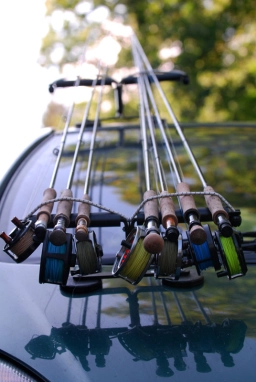
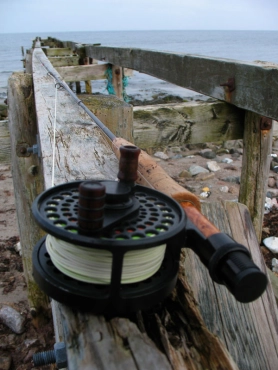

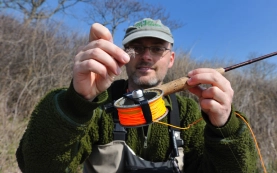
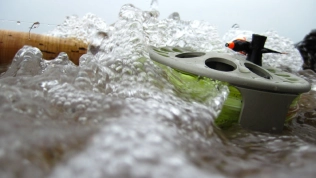
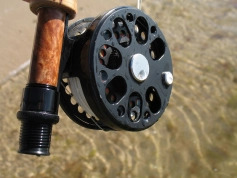
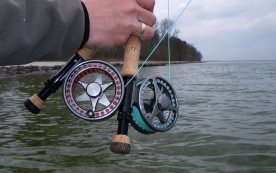
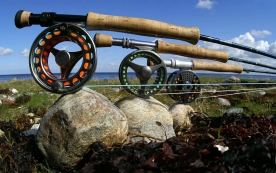
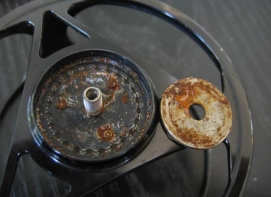
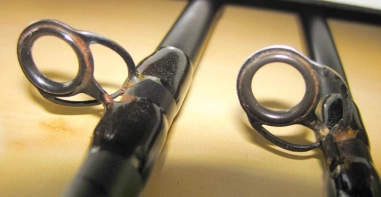
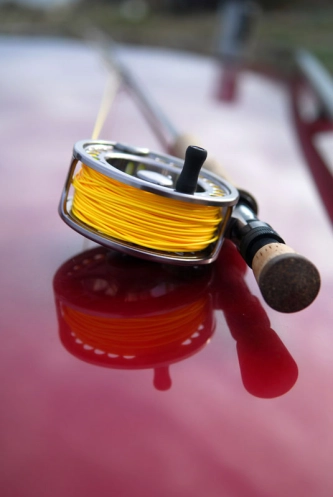
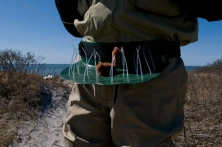

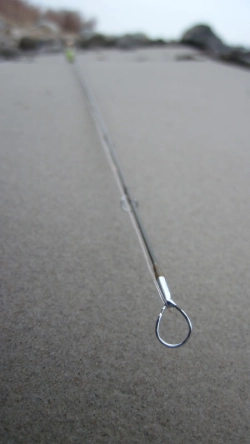

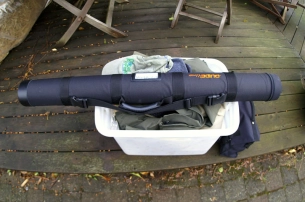
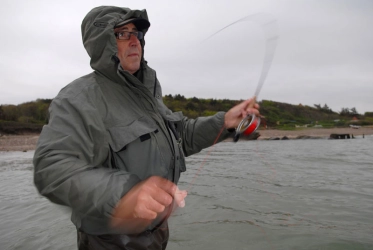
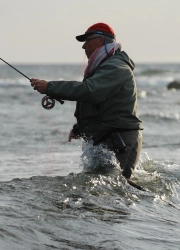


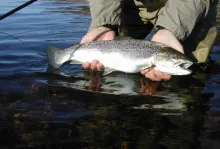
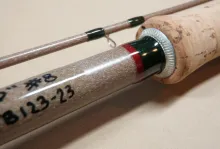
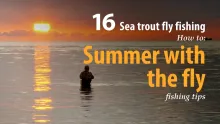


A very interesting a
A very interesting article. Most of what you write is very much applicable to the popular fly fishery here in Puget Sound in the northwest corner of Washington State. Our quarry, of course, differs; the sea-run cutthroat (Oncorhynchus clarki clarki, the anadromous form of the coastal cutthroat trout) being the most popular. We also fish for resident coho (Oncorhynchus kisutch), coho salmon who have foregone the opportunity to go to the ocean, choosing instead to remain within the Sound and even the occasional "blackmouth", a king, or chinook salmon (Oncorhynchus tschawytscha) which has opted to live out a similar life history. And, during the late summer and fall, mature members of all of the Pacific salmon species become available to the angler as they return to their natal streams to spawn.
Tackle and techniques seem to be very much alike. Thanks for a good look at fishing in the Baltic.
Fantastic article ag
Fantastic article again Martin. I've been having same type of experiences that you about rod lenghts and weights.
Here in Finnish coast most used fishing gear is still 8-weight 9 feet extremely stiff rod. I just can't imagine any condition of weather that I would need more than maximum 7-weight medium-fast rod.
Nowadays I'm using mostly Guideline's 5-weight LpXe Rs rod ( older, 3-piece ) and I've seen the difference with lighter gear.
Most of my fish are goming to the shore much more easily than with a stiff heavier rod. And earlier when I used 8-weights most of the fish escaped maybe because of that stiffness.
About those lines.
I've been using earlier mostly shooting heads and floting runningline ( no monofilaments for me ) , but when I first had Guidelines coastal line in my hands there's been no returning to those shooting heads again.
I just hated that loop to loop connection when it did get true my rods guides. It just wasn't suitable for me.
I've been using that same flyline for 3 years now and still no crackings anywhere. Maybe you guys are too ruff for your lines.
Anonymous,
I have
Anonymous,
I have never experienced play in any Litespeed reels, so yours might be worn or have a defect. The central bearing/brake assembly can be changed and it might be an idea to take it to a dealer and have it checked. The Lamson reels are usually very good, and even their inexpensive models such as the Radius are built to a high standard. My Radius has had a few rust problems, but has no play at all, and as far as I know it employs the same central construction as the other Lamson reels.
Martin
Great article.
Just
Great article.
Just bought an old model Lamson Litespeed as in the picture - looks wonderful but has a little lateral play between the spool and frame - is this usual? Have an old model ULA Force F3 and that has zero play so slightly disappointed in the difference in quality..........
I really like the ar
I really like the article because I like flyfishing tackle :-)
I agree with Martin that "hybrid lines that combine a shooting head like front part with a thin running line" are worn and cracked after one season as my Rio Outbound is the proof. But on the other hand I spend less time on the Baltic coast than Martin so one Martin season is three seasons on the coast for me :-)
I would like to add one quotation from one czech movie: "It depends on each commrade's taste". So Martin is right in his last comment.
...using the same se
...using the same selection of scierra rods, even sold my #7sage :)
Sarunas,
While I
Sarunas,
While I cerrtainly consider your setup a very nice and useful one (and I like the cheap-factor!), it just shows exactly what I try to point out in the article: it's a personal choice.
I would never use a mono shooting line.
And a stripping basket...? Over my dead body! I dislike them and never use them. Many of my fishing friends do, but I personally don't. I have one that I sometimes mount on my pontoon boat to avoid tangles, but for wading: a floating shooting line and no basket for me please.
Martin
The best set in my o
The best set in my opinion is:
Vision Nite Catapult #6-7 9'6
Vision Attack shooting head 7#
and flat mono running line (Varivas or Vision)
Seaguar fluorocarbon tippet and fluorocarbon tapered leader also do its job! It is protected from sand and stones much more than simple monofilament.
Striping basket is a MUST!
That set is really impressive. Casts like hell if you know how to do it!
Also it is cheap. Only one minus is that the rod comes in 3 pieces.
Jan,
I have writt
Jan,
I have written extensively about my shooting heads and running lines over the years, and you can check out these articles (which you may already know):
Shooting Heads
Fly Line Blues
Shooting Lines
And of course there's much more filed under the keywords shooting heads and fly lines.
I tend to use home made shooting heads fabricated from cheap mill end lines. They are mostly slow sinking or neutral with a few floaters in there. I have a ton of them. They are cheap to make and easy to exchange, so I tend to have a whole bunch, but I typically fish the same setups for long periods and don't change much while fishing.
My preferred shooting line is still the braided HT-line, which hasn't been made for more than 10 years now, so I'm running on the last reserves here. But they still work better for me than anything else.
Martin
Hi Martin,
thanks
Hi Martin,
thanks for your thoughtful article about gear. I like to read stuff like that from experienced flyfishermen. I would be also interested in the shooting heads and running lines you use with your rods as an very interesting complement.
All the best
Jan
Rod
Hey, Martin!
Great article!
What's your opinion about switch rods for sea trout fishing? I think it would be a good choice for longer casts?
Cheers
Long rods on the coast
Magnus,
I actually don't think switch rods will give you any advantages on the coast, and certainly not longer casts.
Switch rods give great line control for underhand and spey style casting as well as for mending, but doesn't actually give longer casts. And the longer rods, often 10, 11 and 13 feet, will be a curse once the wind starts blowing - which it does 9 out of 10 days on the coast. The long rod simply gives too much wind resistance, and hardcore saltwater anglers often opt for shorter rods down to 8 feet and less to overcome the wind.
My personal choice is still a 9' rod, which is a good compromise between some reach and comfort as well as gaining the line speed, which is the primary factor in obtaining distance in casting.
Martin
Shooting line
Hi, Martin!
Thanks for your advice on the rod - didn't go for a switch and bought a 9"Fenwick Techna saltwater rod rated #7 for coastal sea trout.
Another thing I'm still confused about, is what shooting line to use. I have tried a monofilament line with a shortened #8 guideline shooting head and I also have a regular airflo 40+ intermediate line. I would prefer the shooting head setup for the ease of use, but the monofilament tangles up occasionally. I read that you use a braided line - do you have any recommendations and what are the pros of braided line? I'm thinking about the Airflo Miracle shooting braid. Not many shooting braids on the market and to be honest, no one has even heard of a shooting braid here in Estonia.
Not decided
Greeting Martin!
Really useful article. I want your opinion about 2 lines and the rod.
http://www.guideline.no/Coastal.d2Y-18UlNO38pBp7q5B8Nxh0xE2N13PYpwtrI4p…
or
http://www.guideline.no/?module=Webshop;action=ProductGroup.publicOpen;…
and the rod
http://www.scierra.com/rods/srxv2/
all #6 class.
I hope you will reply soon and thank you for your time.
No idea
Florin,
I'm sorry, but I have to say that I have no idea which one to choose. I don't know any of the lines or the rod. I can see that it's a full line and a shooting head, and my only comment is that I'd probably choose the shooting head myself for my ordinary fishing and the full line if I was looking for a slightly better presentation. And I'd go for the slow intermediate in both cases.
Hope this helps just a bit.
Martin